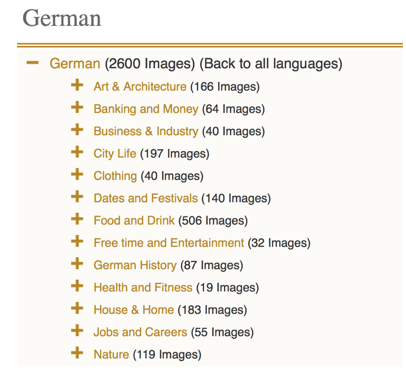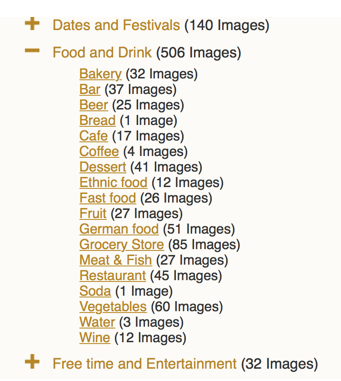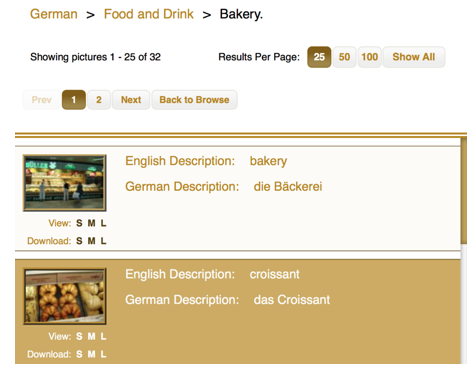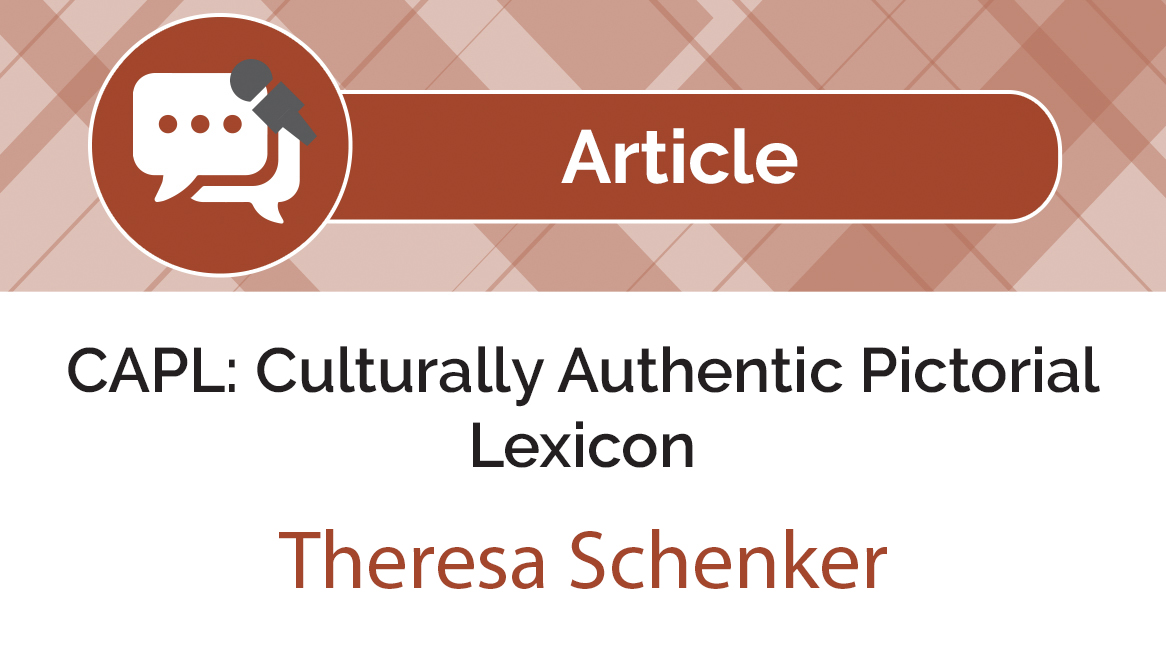CAPL: Culturally Authentic Pictorial Lexicon
 By Theresa Schenker, PhD, Language Program Director & Senior Lector II at Yale University.
By Theresa Schenker, PhD, Language Program Director & Senior Lector II at Yale University.
DOI: https://www.doi.org/10.69732/NSEM6486
One of the primary goals of foreign language instruction apart from the acquisition of target language skills is the development of cultural awareness and intercultural competence. Learning about the target culture is firmly rooted in the ACTFL Standards for Foreign Language Learning (National Standards in Foreign Language Education Project, 1999). According to the guidelines, foreign language instruction should enable students to “communicate and to learn to respond appropriately in a variety of cultures” (1999, p. 245) and in order to do that, students have to have “an understanding of the interdependent and interactive relationship of the perspectives, practices, and products” (1999, p. 257) of a culture. The recent ACTFL World Readiness Standards for Learning Languages include the goal that students should “interact with cultural competence and understanding” (National Standards in Foreign Language Education Project, 2013). They divide this overall goal into two components, relating cultural practices and cultural products to perspectives. Some educators suggest that culture should be at the very heart of language instruction (Sercu, 2005), and that it should not be viewed as an “expendable fifth skill” (Kramsch, 1993, p. 1). In fact, many language instructors today agree on the importance of cultural learning and its central role in the world language classroom (Fantini, 1997; Finger, 2008; Lovik, 2008; Sercu, 2005) and the National Standards in Foreign Language Education (1999) emphasize that “students cannot truly master the language until they have also mastered the cultural contexts in which the language occurs” (p. 31). In spite of the importance of incorporating culture in language classes and enabling students to develop intercultural competence there is still much to learn about the most effective ways to do so.
One way in which instructors have addressed culture in the classroom is through authentic images, photographs, and art-work. Many instructors make use of the affordances of new technologies for bringing authentic videos, photos, images, and artwork into the classroom as part of exposing students to the target culture. In foreign language classrooms, images can be an ideal way to connect culture and language learning (Bush, 2007). Indeed, photos have been used for a variety of learning objectives in a multitude of projects in language classrooms including digital storytelling (Oskoz, 2016; RubyYang, 2011), the creation of picture books (Britsch, 2010; Early & Yeung, 2009), photo diaries (Schwartz & Terry, 2017) and photomontages (Hassaskhah & Asli, 2015), or the design of websites or blogs (Pertusa-Seva & Stewart, 2000).
The website CAPL (Culturally Authentic Pictorial Lexicon) located at http://capl.washjeff.edu is an ideal resource for instructors of students who are looking for authentic images to enhance their cultural teaching and learning. CAPL provides a collection of images from a multitude of cultures. The site was developed by Dr. Michael R. Shaughnessy from Washington & Jefferson College and is intended to help anyone interested in languages and cultures to think more deeply about the connection between words and what they represent in different languages. The website has an advanced search function where users can find images by keyword or language. There are currently 17 different language contexts available on CAPL which contain between 11 and 2544 active images. Unfortunately, many less commonly taught languages are not included in the pictorial lexicon. The website also includes valuable information about including the images in the classroom.
CAPL is completely free of charge. Anyone can access the website and search for images which can be used in class presentations and projects, to introduce new vocabulary, or to discuss cultural perceptions, differences, and similarities. The database is nicely organized into sub-categories which makes finding relevant images easy. See the screenshot below for an example of some of the categories available for German images.

Within each category, there are subcategories that can be seen by clicking the plus button. The image below shows the subcategories within the German category “Food and Drink”.

Within each subcategory there are images with the English description as well as the description in the target language. Images can be downloaded and viewed in different sizes.

In addition to the searchable database of authentic images from a variety of cultures, CAPL includes online activities in the PICTOLANG section of the website. Here, one can play a picture and word matching game, use the visual word trainer (similar to a flashcard game, where one can select the language and sub-topic for the images that are shown), or play a visual analyst game in which one has to guess where an image comes from. CAPL now also includes a blog where many more images are posted.
CAPL is a very useful website that can be applied in a variety of ways in the classroom. Unfortunately, some of the languages don’t have a lot of images yet, and the overall selection of languages that are available is somewhat limited; it would be great if, in the future, the database could be expanded and include more images, languages, and contexts. If you are interested in adding to the database you can contact the creator of the website! All in all, I highly recommend CAPL to anyone working with languages and cultures as an ideal place to find authentic images for use inside and outside of the classroom.
REFERENCES
Britsch, S. (2010). Photo-booklets for English language learning: Incorporating visual communication into early childhood teacher preparation. Early Childhood Education Journal, 38(3), 171–177.
Bush, M. D. (2007). Facilitating the integration of culture and vocabulary learning: The categorization and use of pictures in the classroom. Foreign Language Annals, 40(4), 727-745.
Early, M., & Yeung, C. (2009). Producing multimodal picture books and dramatic performances in a core French classroom: An exploratory case study. The Canadian Modern Language Review, 66(2), 299-322.
Fantini, A. E. (1997). Foreword. In A. E. Fantini (Ed.), New ways in teaching culture (pp. ix-xii). Alexandria: TESOL.
Finger, A. (2008). Hot spot oder hot rod: Interdisziplinarität und interkulturelle Kompetenz. In R. A. Schulz & E. Tschirner (Eds.), Developing an intercultural curriculum: Challenges and lessons learned (pp. 88-105). München: IUDICIUM.
Hassaskhah, J., & Asli, S. R. (2015). Photomontage: A new task to change speaking into talking classrooms. Cogent Education, 2(1), 1-11. doi: 10.1080/2331186X.2015.1125333
Kramsch, C. (1993). Context and culture in language teaching. Oxford: Oxford University Press.
Lovik, T. (2008). Interkulturelle Kompetenz: Ein realistisches Lernziel? Eine Fallstudie aus dem Study Abroad Kontext. In R. A. Schulz & E. Tschirner (Eds.), Communicating across borders: Developing intercultural competence in German as a foreign language (pp. 346-357). München: IUDICIUM.
National Standards in Foreign Language Education Project. (1999). Standards for foreign language learning in the 21st century. Lawrence: Allen Press.
National Standards in Foreign Language Education Project. (2013). World-readiness standards for foreign language learning. Retrieved 3/1/2018, from https://www.actfl.org/sites/default/files/publications/standards/World-ReadinessStandardsforLearningLanguages.pdf
Oskoz, A. (2016). Digital stories: Bringing multimodal texts to the Spanish writing classroom. ReCALL, 28(3), 326-342.
Pertusa-Seva, I., & Stewart, M. A. (2000). Virtual study abroad 101: Expanding the horizons of the Spanish curriculum. Foreign Language Annals, 33(4), 438-441.
RubyYang, C. C. (2011). Using Microsoft Photo Story for Digital Storytelling in the Language Classroom. TESL-EJ, 15(2), 1-9.
Schwartz, A., & Terry, H. (2017). Seeing the unheard: Heritage learners of Spanish and photo-diary pedagogy. International Multilingual Research Journal, 11(4), 223-238.
Sercu, L. (Ed.). (2005). Foreign language teachers and intercultural competence. Clevedon: Multilingual Matters LTD.


Is CAPL still active?
I would like to know the same, and if there is any different way to get to the pictures
As far as I can tell, it no longer exists, which is too bad!